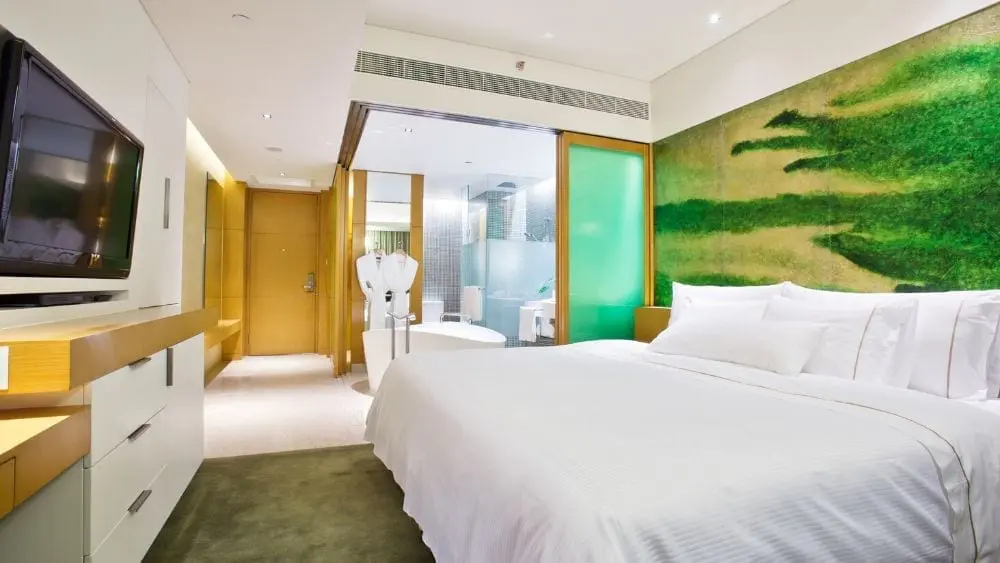
There’s a long history of designers in different fields borrowing ideas from each other.
Fashion designers are inspired by architecture. Sometimes landscape architects mirror concepts from interior design. And residential interior designers can find their vision for a home by looking to advancements in hotel design.
Why not? The design disciplines have never been exclusive and oftentimes designers do projects in more than one field. Influence goes both ways.
“At first, hotels tried to resemble homes to make the spaces more familiar and inviting to guests,” says Svetlana Muzaleva, principal designer at Next Design Studio in Santa Monica, Calif. “Now, with more boutique hotels popping up, more main hotel brands opening their own boutique sub brands, boutique hotels are getting enormous exposure on social media.”
Boutique hotels are uniquely positioned to offer ideas for residential design for the masses because space sizes correspond more directly, but inspiration doesn’t have to be literal. The design of a hallway at a Ritz-Carlton can spark an idea for your home.
Thanks to the ever-evolving hotel industry where competition is fierce, today’s buyers expect chic, yet comfortable, accommodations in their day-to-day lives. “Hotel features that translate well into residential design include floor-to-ceiling glass lobbies, expansive rooftop terraces, high-level finishes, fitness rooms, flexible indoor/outdoor spaces and a variety of suite configurations,” says David M. Kennedy, former principal at the international firm KTGY Architecture + Planning.
Charmaine Wynter of Dallas-Fort Worth, Texas, is a luxury interior design expert working in both hotel and residential design. She also hosts the Living Well show and says that her knowledge of design fundamentals and functional space planning translates to both residential and commercial projects.
“I often utilize hospitality rated materials into my residential projects. The most common way I see this translating is the overall luxe design sensibility,” she says.
Hotel-Worthy Furnishings and Decor
Theresa Parsons of Selfridge Design in Rochester, N.Y., notes that “hospitality design has opened up the market for furnishings that have a decidedly residential look, whether they are traditional or modern in style. Fabrics and finishes that are designed to withstand public-level use are ideal for anyone looking to invest in decor they won’t need to replace frequently due to wear and tear, especially young parents.”
Thanks to competition in the marketplace, the cost of these furnishings and finishes is coming down, making them affordable for residential use.
“As manufacturers continue to create tactile, organic and appropriate colors and finishes for the commercial market, we have found that these same materials work beautifully in the residential arena,” says interior designer LaMar Lisman of Lisman Studio in Salt Lake City, Utah. “Hospitality furnishings and fabrics are, first and foremost, durable. At Lisman Studio we consistently use these products to create practical and sustainable spaces for our residential clients. A great example would be when the firm recently specified a wonderful commercial fabric for a large sectional sofa in a busy young family’s great room. What would normally be appropriate for a hotel lobby banquette suddenly has great application for a client’s home.”
Wynter and her clients also like to appropriate the top-grade materials and finishes found at hotels.
“I implement this crossover most frequently with wallpaper in my work,” she explains. “Hotel-grade wallpapers are of a superior durability because of the sheer volume of people that use the rooms that these wall coverings inhabit. Thus, they are able to withstand a typical family’s use. These wallpapers also have sound-deadening qualities, which is always a great thing in an open-concept design,” often found in newly built homes.
These wallpapers aren’t just practical, they also have fantastic aesthetic value. As Lisman says, “The hospitality industry is continually a leader in the forecast of color and design material trends and, not surprisingly, closely followed by the residential design market. … Commercial colors and materials tend to be bolder and design driven, making them a fit for the residential client that likes to stay ahead of the curve.”
Client-Driven Design
Before a client embarks on a new interior project, even before they hire an interior designer, they collect ideas on Houzz or Pinterest.
Clients also scan the real world for looks they love. This happens in their daily lives in their hometowns or when they travel.
“A lot of my clients ask for their master bedroom to feel like a hotel or for their bathroom to feel like a spa,” says Liz Toombs, owner and president of Polka Dots & Rosebuds Interiors in Lexington, Ky. “Their goal is for those spaces to evoke the relaxing feelings they have when they are at a hotel on vacation.”
Toombs helps clients accomplish this with features her clients find in hotels: Luxurious bed linens, soothing wall colors (aquas, grays, blues), dark wood tones, touches of metallics in accessories and artwork, floor-to-ceiling curtains for a romantic feel, a seating area within the bedroom, frameless glass for showers and granite countertops and tile floors in bathrooms.

Sarah Kinbar is a writer and editor with a passion for design and images. She was the editor of Garden Design magazine, curating coverage of residential gardens around the globe. As the editor of American Photo, Kinbar worked with photographers of every genre to create a magazine that told the story of the photographer’s journey.
She has been writing about architecture, landscape design and new-home construction for NewHomeSource since 2012. During that time, she founded Kinship Design Marketing, a boutique agency that provides content for website redesigns, blogs, inbound marketing campaigns and eNewsletters.
 What is Transitional Architecture?
What is Transitional Architecture?